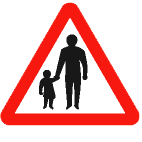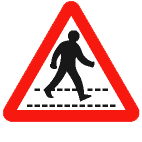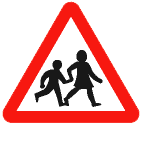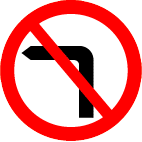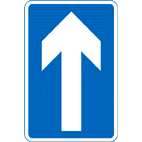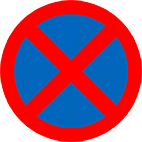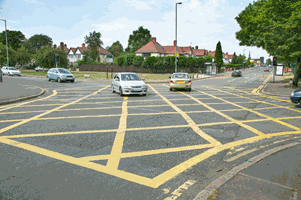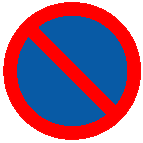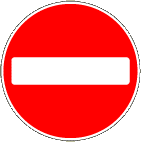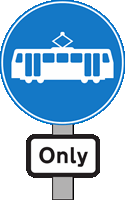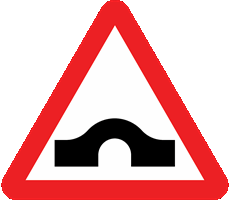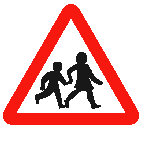You have 57 minutes to answer 50 multiple choice theory test questions. You need to answer at least 43 out of 50 questions correctly to pass. You can review your answer after each question or you can review all of your answers at the end of the test. Best of luck!
Test Quick View
Click on an answer to view the correct choice along with the explanation.
Correct Answer: A, B, E
Explanation: When you see emergency vehicles with blue flashing beacons, move out of the way as soon as it is safe to do so.
Explanation: When you see emergency vehicles with blue flashing beacons, move out of the way as soon as it is safe to do so.
B
C
D
Correct Answer: C
Explanation: If you're travelling in a one-way street and wish to turn right you should take up a position in the right-hand lane. This will enable other road users not wishing to turn to proceed on the left. Indicate your intention and take up your position in good time.
Explanation: If you're travelling in a one-way street and wish to turn right you should take up a position in the right-hand lane. This will enable other road users not wishing to turn to proceed on the left. Indicate your intention and take up your position in good time.
3. Which sign tells you that pedestrians may be walking in the road as there is no pavement?
Mark one answer
B
C
D
Correct Answer: A
Explanation: Give pedestrians who are walking at the side of the road plenty of room when you pass them. They may turn around when they hear your engine and unintentionally step into the path of your vehicle.
Explanation: Give pedestrians who are walking at the side of the road plenty of room when you pass them. They may turn around when they hear your engine and unintentionally step into the path of your vehicle.
Correct Answer: C
Explanation: Another road user failing to see a motorcyclist is a major cause of collisions at junctions. Wherever streams of traffic join or cross there's the potential for this type of incident to occur.
Explanation: Another road user failing to see a motorcyclist is a major cause of collisions at junctions. Wherever streams of traffic join or cross there's the potential for this type of incident to occur.
5. You are about to overtake a slow-moving motorcyclist. Which one of these signs would make you take special care?
Mark one answer
B
C
D
Correct Answer: A
Explanation: In windy weather, watch out for motorcyclists and also cyclists as they can be blown sideways into your path. When you pass them, leave plenty of room and check their position in your mirror before pulling back in.
Explanation: In windy weather, watch out for motorcyclists and also cyclists as they can be blown sideways into your path. When you pass them, leave plenty of room and check their position in your mirror before pulling back in.
Correct Answer: A
Explanation: When following a large vehicle keep well back. If you're too close you won't be able to see the road ahead and the driver of the long vehicle might not be able to see you in their mirrors.
Explanation: When following a large vehicle keep well back. If you're too close you won't be able to see the road ahead and the driver of the long vehicle might not be able to see you in their mirrors.
Correct Answer: B
Explanation: You should give way to traffic already on the motorway. Where possible they may move over to let you in but don't force your way into the traffic stream. The traffic may be travelling at high speed so you should match your speed to fit in.
Explanation: You should give way to traffic already on the motorway. Where possible they may move over to let you in but don't force your way into the traffic stream. The traffic may be travelling at high speed so you should match your speed to fit in.
Correct Answer: D
Explanation: Yellow box junctions are marked on the road to prevent the road becoming blocked. Don't enter one unless your exit road is clear. You may only wait in the yellow box if your exit road is clear but oncoming traffic is preventing you from completing the turn.
Explanation: Yellow box junctions are marked on the road to prevent the road becoming blocked. Don't enter one unless your exit road is clear. You may only wait in the yellow box if your exit road is clear but oncoming traffic is preventing you from completing the turn.
Correct Answer: D
Explanation: Look out for traffic signs. Disobeying or not seeing a sign could be dangerous. It may also be an offence for which you could be prosecuted.
Explanation: Look out for traffic signs. Disobeying or not seeing a sign could be dangerous. It may also be an offence for which you could be prosecuted.
Correct Answer: D
Explanation: Take extra care when you encounter trams. Look out for road markings and signs that alert you to them. Modern trams are very quiet and you may not hear them approaching
Explanation: Take extra care when you encounter trams. Look out for road markings and signs that alert you to them. Modern trams are very quiet and you may not hear them approaching
Correct Answer: C
Explanation: Sometimes an insurance company will issue a temporary insurance certificate called a cover note. It gives you the same insurance cover as your certificate, but lasts for a limited period, usually one month.
Explanation: Sometimes an insurance company will issue a temporary insurance certificate called a cover note. It gives you the same insurance cover as your certificate, but lasts for a limited period, usually one month.
Correct Answer: A, C
Explanation: A rumble device usually consists of raised markings or strips across the road. It gives an audible, visual and tactile warning of a hazard. These strips are found in places where traffic has constantly ignored warning or restriction signs. They are there for a good reason. Slow down and be ready to deal with a hazard.
Explanation: A rumble device usually consists of raised markings or strips across the road. It gives an audible, visual and tactile warning of a hazard. These strips are found in places where traffic has constantly ignored warning or restriction signs. They are there for a good reason. Slow down and be ready to deal with a hazard.
13. You are on a two-lane dual carriageway. For which TWO of the following would you use the right-hand lane?
Mark two answers
B
C
D
E
F
Correct Answer: D, F
Explanation: Normally you should travel in the left-hand lane and only use the right-hand lane for overtaking or turning right. Move back into the left lane as soon as it's safe but don't cut in across the path of the vehicle you've just passed.
Explanation: Normally you should travel in the left-hand lane and only use the right-hand lane for overtaking or turning right. Move back into the left lane as soon as it's safe but don't cut in across the path of the vehicle you've just passed.
Correct Answer: A, B, D
Explanation: Trams can run on roads used by other vehicles and pedestrians. The part of the road used by the trams is known as the reserved area and this should be kept clear. It has a coloured surface and is usually edged with white road markings. It might also have different surface texture.
Explanation: Trams can run on roads used by other vehicles and pedestrians. The part of the road used by the trams is known as the reserved area and this should be kept clear. It has a coloured surface and is usually edged with white road markings. It might also have different surface texture.
Correct Answer: A
Explanation: You should normally travel in the left-hand lane unless you are overtaking a slower-moving vehicle. When you are past that vehicle move back into the left-hand lane as soon as it's safe to do so. Don't cut across in front of the vehicle that you're overtaking.
Explanation: You should normally travel in the left-hand lane unless you are overtaking a slower-moving vehicle. When you are past that vehicle move back into the left-hand lane as soon as it's safe to do so. Don't cut across in front of the vehicle that you're overtaking.
Correct Answer: A, E
Explanation: It may be tempting to park where you shouldn't while you run a quick errand. Careless parking is a selfish act and could endanger other road users.
Explanation: It may be tempting to park where you shouldn't while you run a quick errand. Careless parking is a selfish act and could endanger other road users.
17. There is a police car following you. The police officer flashes the headlights and points to the left. What should you do?
Mark one answer
B
C
D
Correct Answer: B
Explanation: You must pull up on the left as soon as it's safe to do so and switch off your engine.
Explanation: You must pull up on the left as soon as it's safe to do so and switch off your engine.
Correct Answer: A
Explanation: You will need to slow down. At hump bridges your view ahead will be restricted and the road will often be narrow on the bridge. If the bridge is very steep or your view is restricted sound your horn to warn others of your approach. Going too fast over the bridge is highly dangerous to other road users and could even cause your wheels to leave the road, with a resulting loss of control.
Explanation: You will need to slow down. At hump bridges your view ahead will be restricted and the road will often be narrow on the bridge. If the bridge is very steep or your view is restricted sound your horn to warn others of your approach. Going too fast over the bridge is highly dangerous to other road users and could even cause your wheels to leave the road, with a resulting loss of control.
Correct Answer: D
Explanation: Emergency Refuge Areas may be found at the side of the hard shoulder about 500 metres apart. If you break down you should use them rather than the hard shoulder if you are able. When re-joining the motorway you must remember to take extra care especially when the hard shoulder is being used as a running lane within an Active Traffic Management area. Try to match your speed to that of traffic in the lane you are joining.
Explanation: Emergency Refuge Areas may be found at the side of the hard shoulder about 500 metres apart. If you break down you should use them rather than the hard shoulder if you are able. When re-joining the motorway you must remember to take extra care especially when the hard shoulder is being used as a running lane within an Active Traffic Management area. Try to match your speed to that of traffic in the lane you are joining.
B
C
D
Correct Answer: D
Explanation: Other drivers or riders may have to change course due to the size or characteristics of their vehicle. Understanding this will help you to anticipate their actions. Motorcyclists and cyclists will be checking the road ahead for uneven or slippery surfaces, especially in wet weather. They may need to move across their lane to avoid surface hazards such as potholes and drain covers.
Explanation: Other drivers or riders may have to change course due to the size or characteristics of their vehicle. Understanding this will help you to anticipate their actions. Motorcyclists and cyclists will be checking the road ahead for uneven or slippery surfaces, especially in wet weather. They may need to move across their lane to avoid surface hazards such as potholes and drain covers.
Correct Answer: A
Explanation: Using the controls smoothly can reduce fuel consumption by about 15% as well as reducing wear and tear on your vehicle. Plan ahead and anticipate changes of speed well in advance. This will reduce the need to accelerate rapidly or brake sharply.
Explanation: Using the controls smoothly can reduce fuel consumption by about 15% as well as reducing wear and tear on your vehicle. Plan ahead and anticipate changes of speed well in advance. This will reduce the need to accelerate rapidly or brake sharply.
Correct Answer: B
Explanation: With people's concern today for the environment, cycle routes are being created in our towns and cities. These are usually defined by road markings and signs. Respect the presence of cyclists on the road and give them plenty of room if you need to pass.
Explanation: With people's concern today for the environment, cycle routes are being created in our towns and cities. These are usually defined by road markings and signs. Respect the presence of cyclists on the road and give them plenty of room if you need to pass.
Correct Answer: B
Explanation: Police officers may need to direct traffic, for example, at a junction where the traffic lights have broken down. Check your copy of The Highway Code for the signals that they use.
Explanation: Police officers may need to direct traffic, for example, at a junction where the traffic lights have broken down. Check your copy of The Highway Code for the signals that they use.
Correct Answer: A
Explanation: Look well ahead and check the pavements and surrounding areas for pedestrians. Look for anyone walking towards the crossing. Check your mirrors for traffic behind, in case you have to slow down or stop.
Explanation: Look well ahead and check the pavements and surrounding areas for pedestrians. Look for anyone walking towards the crossing. Check your mirrors for traffic behind, in case you have to slow down or stop.
Correct Answer: C
Explanation: If you attempt to move off in a low gear, such as first, the engine will rev at a higher speed. This could cause the wheels to spin and dig further into the snow.
Explanation: If you attempt to move off in a low gear, such as first, the engine will rev at a higher speed. This could cause the wheels to spin and dig further into the snow.
26. You are driving past a line of parked cars. You notice a ball bouncing out into the road ahead. What should you do?
Mark one answer

B
C
D
Correct Answer: C
Explanation: Beware of children playing in the street and running out into the road. If a ball bounces out from the pavement, slow down and stop. Don't encourage anyone to retrieve it. Other road users may not see your signal and you might lead a child into a dangerous situation.
Explanation: Beware of children playing in the street and running out into the road. If a ball bounces out from the pavement, slow down and stop. Don't encourage anyone to retrieve it. Other road users may not see your signal and you might lead a child into a dangerous situation.
27. It is very windy. You are behind a motorcyclist who is overtaking a high-sided vehicle. What should you do?
Mark one answer
B
C
D
Correct Answer: B
Explanation: Motorcyclists are affected more by windy weather than other vehicles. In windy conditions, high-sided vehicles cause air turbulence. You should keep well back as the motorcyclist could be blown off course.
Explanation: Motorcyclists are affected more by windy weather than other vehicles. In windy conditions, high-sided vehicles cause air turbulence. You should keep well back as the motorcyclist could be blown off course.
Correct Answer: A
Explanation: If visibility falls below 100 metres (328 feet) in fog, switching on your rear fog lights will help following road users to see you. Don't forget to turn them off once visibility improves: their brightness might be mistaken for brake lights and they could dazzle other drivers.
Explanation: If visibility falls below 100 metres (328 feet) in fog, switching on your rear fog lights will help following road users to see you. Don't forget to turn them off once visibility improves: their brightness might be mistaken for brake lights and they could dazzle other drivers.
29. Whilst driving, the fog clears and you can see more clearly. You must remember to
Mark one answer
B
C
D
Correct Answer: D
Explanation: Bright rear fog lights might be mistaken for brake lights and could be misleading for the traffic behind.
Explanation: Bright rear fog lights might be mistaken for brake lights and could be misleading for the traffic behind.
30. You are on a busy main road and find that you are travelling in the wrong direction. What should you do?
Mark one answer
B
C
D
Correct Answer: D
Explanation: Don't turn round in a busy street or reverse from a side road into a main road. Find a quiet side road and choose a place where you won't obstruct an entrance or exit. Look out for pedestrians and cyclists as well as other traffic.
Explanation: Don't turn round in a busy street or reverse from a side road into a main road. Find a quiet side road and choose a place where you won't obstruct an entrance or exit. Look out for pedestrians and cyclists as well as other traffic.
31. Which FOUR are most likely to cause you to lose concentration while you are driving?
Mark four answers
B
C
D
E
F
Correct Answer: B, C, D, E
Explanation: It's easy to be distracted. Planning your journey before you set off is important. A few sensible precautions are to tune your radio to stations in your area of travel, take planned breaks, and plan your route. Except for emergencies it is illegal to use a hand-held mobile phone while driving. Even using a hands-free kit can distract your attention.
Explanation: It's easy to be distracted. Planning your journey before you set off is important. A few sensible precautions are to tune your radio to stations in your area of travel, take planned breaks, and plan your route. Except for emergencies it is illegal to use a hand-held mobile phone while driving. Even using a hands-free kit can distract your attention.
Correct Answer: B
Explanation: The anti-lock braking system will operate when the brakes have been applied harshly. It will reduce the chances of your car skidding, but it is not a miracle cure for careless driving.
Explanation: The anti-lock braking system will operate when the brakes have been applied harshly. It will reduce the chances of your car skidding, but it is not a miracle cure for careless driving.
33. You are reversing your vehicle into a side road. When would the greatest hazard to passing traffic occur?
Mark one answer
B
C
D
Correct Answer: D
Explanation: Always check road and traffic conditions in all directions before reversing into a side road. Keep a good look-out throughout the manoeuvre. Act on what you see and wait if necessary.
Explanation: Always check road and traffic conditions in all directions before reversing into a side road. Keep a good look-out throughout the manoeuvre. Act on what you see and wait if necessary.
34. You are driving along this road. The driver on the left is reversing from a driveway. You should
Mark one answer
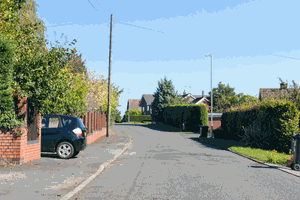
B
C
D
Correct Answer: C
Explanation: White lights at the rear of a car show that it is about to reverse. Sound your horn to warn of your presence and reduce your speed as a precaution.
Explanation: White lights at the rear of a car show that it is about to reverse. Sound your horn to warn of your presence and reduce your speed as a precaution.
Correct Answer: B
Explanation: Sometimes large vehicles may need more space than other road users. If a vehicle needs more time and space to turn be prepared to stop and wait.
Explanation: Sometimes large vehicles may need more space than other road users. If a vehicle needs more time and space to turn be prepared to stop and wait.
Correct Answer: D, E, F
Explanation: Alcohol can increase confidence to a point where a driver's behaviour might become 'out of character'. Someone who normally behaves sensibly suddenly takes risks and enjoys it. Never let yourself or your friends get into this situation.
Explanation: Alcohol can increase confidence to a point where a driver's behaviour might become 'out of character'. Someone who normally behaves sensibly suddenly takes risks and enjoys it. Never let yourself or your friends get into this situation.
B
C
D
Correct Answer: C
Explanation: It is illegal to pour engine oil down any drain. Oil is a pollutant and harmful to wildlife. Dispose of it safely at an authorised site.
Explanation: It is illegal to pour engine oil down any drain. Oil is a pollutant and harmful to wildlife. Dispose of it safely at an authorised site.
38. Why is it particularly important to carry out a check on your vehicle before making a long motorway journey?
Mark one answer
B
C
D
Correct Answer: A
Explanation: Before you start your journey make sure that your vehicle can cope with the demands of high-speed driving. You should check a number of things, the main ones being oil, water and tyres. You also need to plan rest stops if you're going a long way.
Explanation: Before you start your journey make sure that your vehicle can cope with the demands of high-speed driving. You should check a number of things, the main ones being oil, water and tyres. You also need to plan rest stops if you're going a long way.
Correct Answer: D
Explanation: Hazard warning lights are an important safety feature and should be used if you have broken down and are causing an obstruction. Don't use them as an excuse to park illegally such as when using a cash machine or post box. You may also use them on motorways to warn traffic behind you of danger ahead.
Explanation: Hazard warning lights are an important safety feature and should be used if you have broken down and are causing an obstruction. Don't use them as an excuse to park illegally such as when using a cash machine or post box. You may also use them on motorways to warn traffic behind you of danger ahead.
Correct Answer: B
Explanation: When going downhill, prolonged use of the brakes can cause them to overheat and lose their effectiveness. Changing to a lower gear will assist your braking.
Explanation: When going downhill, prolonged use of the brakes can cause them to overheat and lose their effectiveness. Changing to a lower gear will assist your braking.
41. When driving a car fitted with automatic transmission what would you use 'kick down' for?
Mark one answer
B
C
D
Correct Answer: C
Explanation: Kick down' selects a lower gear, enabling the vehicle to accelerate faster.
Explanation: Kick down' selects a lower gear, enabling the vehicle to accelerate faster.
Correct Answer: A
Explanation: During long journeys an engine can use more oil than on shorter trips. Insufficient oil is potentially dangerous: it can lead to excessive wear and expensive repairs.Most cars have a dipstick to allow the oil level to be checked. If not, you should refer to the vehicle's handbook. Also make checks on
- fuel,
- water,
- tyres.
Explanation: During long journeys an engine can use more oil than on shorter trips. Insufficient oil is potentially dangerous: it can lead to excessive wear and expensive repairs.Most cars have a dipstick to allow the oil level to be checked. If not, you should refer to the vehicle's handbook. Also make checks on
- fuel,
- water,
- tyres.
Correct Answer: B
Explanation: A minor incident in a tunnel can quickly turn into a major disaster. Variable message signs are provided to warn of any incidents or congestion. Follow their advice.
Explanation: A minor incident in a tunnel can quickly turn into a major disaster. Variable message signs are provided to warn of any incidents or congestion. Follow their advice.
Correct Answer: D
Explanation: Using a vehicle for short journeys means the engine does not have time to reach its normal running temperature. When an engine is running below its normal running temperature it produces increased amounts of pollution. Walking and cycling do not create pollution and have health benefits as well.
Explanation: Using a vehicle for short journeys means the engine does not have time to reach its normal running temperature. When an engine is running below its normal running temperature it produces increased amounts of pollution. Walking and cycling do not create pollution and have health benefits as well.
45. How can you reduce the chances of your car being broken into when leaving it unattended?
Mark one answer
B
C
D
Correct Answer: D
Explanation: When leaving your car take all valuables with you if you can, otherwise lock them out of sight.
Explanation: When leaving your car take all valuables with you if you can, otherwise lock them out of sight.
46. You are driving towards a zebra crossing. A person in a wheelchair is waiting to cross. What should you do?
Mark one answer
B
C
D
Correct Answer: A
Explanation: You should slow down and be prepared to stop as you would with an able-bodied person. Don't wave them across as other traffic may not stop.
Explanation: You should slow down and be prepared to stop as you would with an able-bodied person. Don't wave them across as other traffic may not stop.
Correct Answer: B
Explanation: Whenever possible park in an area which will be well lit at night.
Explanation: Whenever possible park in an area which will be well lit at night.
48. A trailer must stay securely hitched up to the towing vehicle. What additional safety device can be fitted to the trailer braking system?
Mark one answer
B
C
D
Correct Answer: A
Explanation: In the event of a towbar failure the cable activates the trailer brakes, then snaps. This allows the towing vehicle to get free of the trailer and out of danger.
Explanation: In the event of a towbar failure the cable activates the trailer brakes, then snaps. This allows the towing vehicle to get free of the trailer and out of danger.
49. It is a very windy day and you are about to overtake a cyclist. What should you do?
Mark one answer
B
C
D
Correct Answer: A
Explanation: Cyclists, and motorcyclists, are very vulnerable in crosswinds. They can easily be blown well off course and veer into your path. Always allow plenty of room when overtaking them. Passing too close could cause a draught and unbalance the rider.
Explanation: Cyclists, and motorcyclists, are very vulnerable in crosswinds. They can easily be blown well off course and veer into your path. Always allow plenty of room when overtaking them. Passing too close could cause a draught and unbalance the rider.
Correct Answer: D
Explanation: Try to look ahead and read the road. Plan your approach to junctions and select the correct gear in good time. This will give you the control you need to deal with any hazards that occur.You'll coast a little every time you change gear. This can't be avoided, but it should be kept to a minimum.
Explanation: Try to look ahead and read the road. Plan your approach to junctions and select the correct gear in good time. This will give you the control you need to deal with any hazards that occur.You'll coast a little every time you change gear. This can't be avoided, but it should be kept to a minimum.



